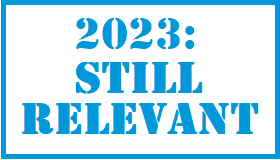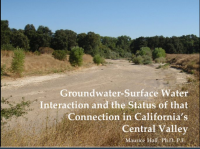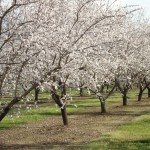Massive Transfers Threaten North State Farms, Fish and Communities
 AquAlliance filed a lawsuit in federal District Court against the U.S. Bureau of Reclamation (USBR) and San Luis Delta Mendota Water Authority (SLDMWA) over their inadequate disclosure, avoidance of impacts, and mitigation of major water transfers from the Sacramento Valley through the Delta to the San Joaquin Valley. USBR and SLDMWA (Agencies) approved a 10-Year Water Transfer Program (Program) that could send up to 600,000 acre-feet of Sacramento Valley water south of the Delta – each year. 1 When combined with additional state approved transfers, the total could be over 800,000 acre-feet each year. If history is any guide, half of the transfer water may come from groundwater substitution. 2 Although widely opposed by NorthState residents and local government, the Agencies moved forward approving the use of groundwater substitution, fallowing, reservoir releases, and conservation to make the transfers possible. The Agencies proposed a thin veneer for mitigating impacts that depends only on monitoring the stressed hydrologic systems (groundwater, streams, and rivers) to produce data that will be reviewed in the future by USBR and the California Department of Water Resources (DWR). The lawsuit asks the court to declare that the Agencies’ Environmental Impact Statement/Report was arbitrary and capricious, ignored relevant new information and failed to meet minimum requirements of the National Environmental Policy Act (NEPA) and the California Environmental Quality Act (CEQA). The Agencies failed to fully disclose the impacts from the Program and the numerous unknown or changing conditions that currently exist, such as where/how groundwater will be recharged and how the Program will further inhibit the USBR’s ability to meet Delta flow and water quality standards that have already been weakened multiple times in 2014 and 2015. The EIS/EIR also reached conclusions based on faith, making the assumption that existing groundwater depletions compounded by the Program might recover during future wet years. 3 AquAlliance Executive Director Barbara Vlamis explained, “Draining the last, relatively healthy watershed as a last ditch effort to prop up a failing system is madness. This Program will strain the Sacramento River Watershed and the Delta facilitating the continued abuses of growers in the western San Joaquin Valley who have already destroyed their own watershed. Let’s call it what it is – a water-grab that will exacerbate the severe impacts already caused by water exports to agricultural interests with junior water rights that chose to plant permanent crops in a desert.” AquAlliance has been joined by the California Sportfishing Protection Alliance and they are represented by the Aqua Terra Aeris law firm. Co-plaintiffs in the litigation also include Central Delta Water Agency, Local Agencies of the North Delta, and South Delta Water Agency that are represented by the Soluri Meserve law firm.
AquAlliance filed a lawsuit in federal District Court against the U.S. Bureau of Reclamation (USBR) and San Luis Delta Mendota Water Authority (SLDMWA) over their inadequate disclosure, avoidance of impacts, and mitigation of major water transfers from the Sacramento Valley through the Delta to the San Joaquin Valley. USBR and SLDMWA (Agencies) approved a 10-Year Water Transfer Program (Program) that could send up to 600,000 acre-feet of Sacramento Valley water south of the Delta – each year. 1 When combined with additional state approved transfers, the total could be over 800,000 acre-feet each year. If history is any guide, half of the transfer water may come from groundwater substitution. 2 Although widely opposed by NorthState residents and local government, the Agencies moved forward approving the use of groundwater substitution, fallowing, reservoir releases, and conservation to make the transfers possible. The Agencies proposed a thin veneer for mitigating impacts that depends only on monitoring the stressed hydrologic systems (groundwater, streams, and rivers) to produce data that will be reviewed in the future by USBR and the California Department of Water Resources (DWR). The lawsuit asks the court to declare that the Agencies’ Environmental Impact Statement/Report was arbitrary and capricious, ignored relevant new information and failed to meet minimum requirements of the National Environmental Policy Act (NEPA) and the California Environmental Quality Act (CEQA). The Agencies failed to fully disclose the impacts from the Program and the numerous unknown or changing conditions that currently exist, such as where/how groundwater will be recharged and how the Program will further inhibit the USBR’s ability to meet Delta flow and water quality standards that have already been weakened multiple times in 2014 and 2015. The EIS/EIR also reached conclusions based on faith, making the assumption that existing groundwater depletions compounded by the Program might recover during future wet years. 3 AquAlliance Executive Director Barbara Vlamis explained, “Draining the last, relatively healthy watershed as a last ditch effort to prop up a failing system is madness. This Program will strain the Sacramento River Watershed and the Delta facilitating the continued abuses of growers in the western San Joaquin Valley who have already destroyed their own watershed. Let’s call it what it is – a water-grab that will exacerbate the severe impacts already caused by water exports to agricultural interests with junior water rights that chose to plant permanent crops in a desert.” AquAlliance has been joined by the California Sportfishing Protection Alliance and they are represented by the Aqua Terra Aeris law firm. Co-plaintiffs in the litigation also include Central Delta Water Agency, Local Agencies of the North Delta, and South Delta Water Agency that are represented by the Soluri Meserve law firm.
2. Groundwater substitution transfers take place when a water district sells its river water that is normally used to irrigate rice and instead continues growing rice by pumping well water. The grower makes money on both the water sale and the rice that is grown
3. FEIS/EIR page 3.3-57. “Though Sacramento Valley and other parts of California are currently noticing declining groundwater level trends, past groundwater trends are indicative of groundwater levels declining moderately during extended droughts and recovering to pre-drought levels after subsequent wet periods.”
4 The Environmental Water Account ended in 2007 (Bay Delta Conservation Plan Draft EIS/EIR 2013). The figures that continue in this row are based on a long-term contract with the Yuba County Water Agency to sell water
Additional Contacts:
Bill Jennings, CSPA: 209-464-5067; cell 209-938-9053
Osha Meserve, Soluri Meserve: 916.455.7300; cell 916-425-9914
Background
1) U.S. Bureau of Reclamation /SLDMWA 10-Year Water Transfer Program http://www.usbr.gov/mp/cvp/ltwt/ and http://www.usbr.gov/mp/nepa/nepa_projdetails.cfm?Project_ID=18361
2) Maps illustrating the groundwater conditions in the Sacramento Valley.
3) Past Water Transfers from the Sacramento Valley Through the Delta as reported in the Western Canal Water District Negative Declarations for 2010 and 2015.
*Table reflects gross AF purchased prior to 20% Delta carriage loss (i.e., actual amounts pumped at Delta are 20% less or more)
** Based on DWR’s measured unimpaired runoff (in million acre-feet) Abbreviations: AN – Above normal year type and BN – Below normal year type (http://cdec.water.ca.gov/cgi-progs/iodir/wsihist)









